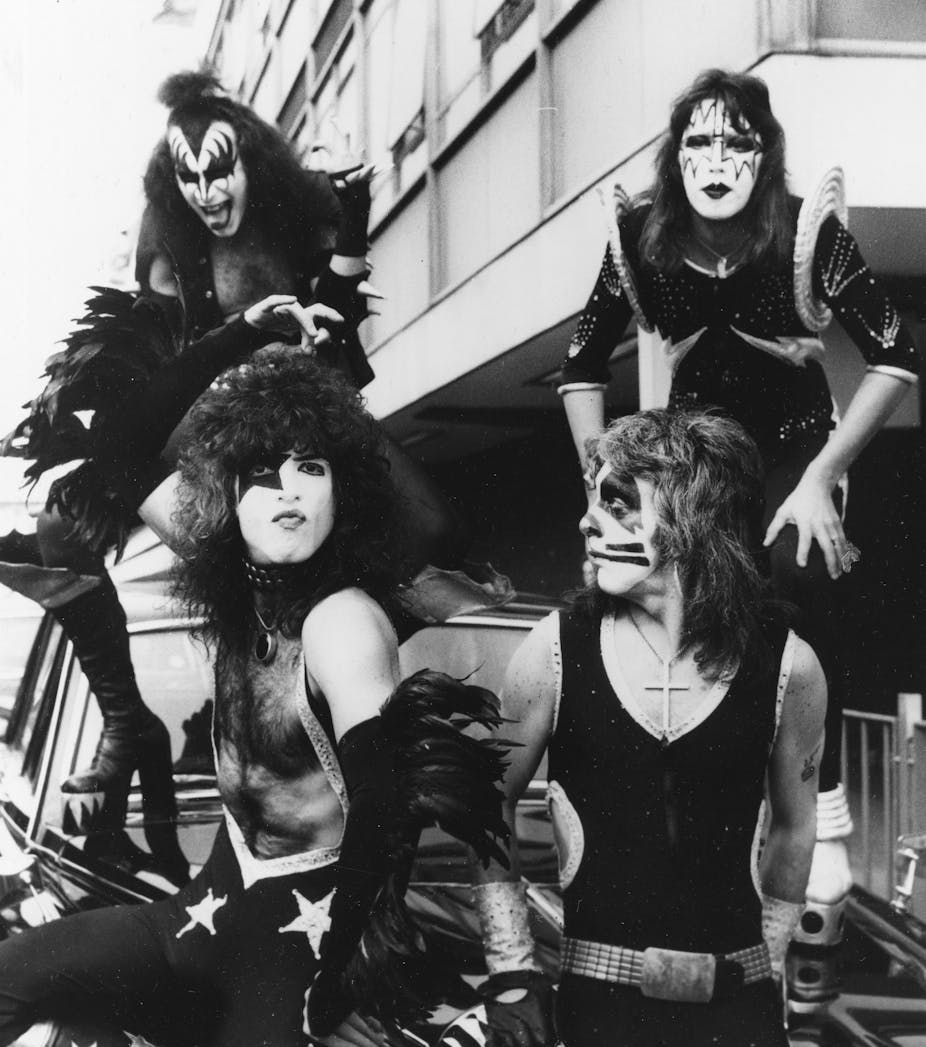It has been 50 years since Rock & Roll Hall of Famers Kiss launched their thunderock-doused debut album into the pop culture stratosphere. The eponymous album, released on February 18 1974, became a platform-stacked foot in the music industry’s door.
What followed established Kiss as one of the most memorable hard-rock bands of the 1970s and ’80s, with a globally recognised legacy.
The early days
In 1972, Paul Stanley and Gene Simmons shelved their first ever rock outfit following a short stint in a band called Wicked Lester. The pair then hatched a plan to form a far more aggressive and successful rock band. Drummer Peter Criss and guitarist Ace Frehley were recruited, and the new-generation Fab Four renamed themselves Kiss.
By late November of 1973, the band had developed their bombastic live performance style, perfected their makeup and signed a deal with Casablanca Records. Yet they dealt with some rocky beginnings.
Armed with reworked songs from Wicked Lester, Kiss entered New York’s Bell Sound Studios to record their debut. A mere three weeks later the album was complete – but the band quickly realised the studio recordings didn’t capture the essence of their high-energy live shows. As vocalist Paul Stanley told Loudwire:
What was put down on tape was such a timid fraction of what we were in concert. I didn’t understand it because bands who were our contemporaries had much better-sounding albums.
They took another blow while shooting the album cover with Joel Brodsky when, after a mishap with Criss’s makeup, the band were allegedly handed balloons by the photographer since he thought they were clowns.
Then, soon before the album was released, Warner Brothers pulled its financial backing and distribution deal from Casablanca Records after witnessing Kiss play a New Year’s eve show. Although it’s said the band’s makeup was the last straw for the label, the show in question also featured Simmons setting his hair alight shortly after throwing a fireball at a fan’s face.
Despite the blunders, the release of the first album set Kiss on a path to becoming immortalised. As Stanley says in his book Face The Music:
For all the minuses I felt about the sound or the cover, we now had a finished album which was the prerequisite for all the other things we wanted to do. We were in the game now.
The Kiss sound
I first heard Kiss as a teenager. I’d just thrift-scored a pair of ’80s-era roller-skates with the band’s logo scrawled on the heels in glitter glue. The salesperson, responsible for the glitter glue, enthusiastically recounted seeing Kiss play VFL Park (now Waverley Park stadium) in 1980 and made me promise I’d listen to them.
Overwhelmed by the band’s expansive discography, and the possibility that their name stood for Knights In Satan’s Service, I thought it best to begin from the start.
With their reputation of on-stage pyrotechnics and gore, I’d expected something more akin to Black Sabbath’s Paranoid than the jangly riffs of Let Me Know or Love Theme From Kiss. A 1978 review by Gordon Fletcher for the Rolling Stone also noted this rift. Despite calling the album exceptional, Fletcher described its sound as a cross between Deep Purple and the Doobie Brothers.
Stanley and Simmons have spoken freely about borrowing heavily from a number of mid-century legends, so it’s no surprise that sonically the album was nothing new. The Rolling Stones’ influence can be heard in the songs Deuce and Strutter, while Led Zeppelin and Neil Young are present in Black Diamond.
The album initially hadn’t risen higher than #87 on Billboard’s album charts. A studio cover of Bobby Rydell’s Kissin’ Time was released next as the lead single, but the track only bumped them up to #83. This commercial unviability loomed over Kiss until the release of Alive! in 1975.
Success and beyond
As the band’s first live album, Alive! bridged the gap between the audacious intensity of Kiss’s performances and the timidness of their studio recordings. Their early tracks were repurposed to let listeners remotely experience the infamous Kiss live spectacle.
As Rock and Roll All Nite claimed #12 on the Billboard charts, the platform-stacked foot burst through the door to mainstream success.

Fifty years after Kiss first stepped into Bell Sound Studios, the band played their final sold-out show at Madison Square Garden on December 2 2023. The performance served as a crowning jewel on their End of the Road world tour, a four-year effort with more than 250 live shows.
Promised to be their biggest and best shows ever, the farewell became a colossal celebration of the band’s legacy. Theatrical pyrotechnics, fake blood and Stanley’s classic opening line – “you wanted the best, you got the best” – were featured at each performance.
While both Kiss’s anthemic numbers and earlier catalogue were performed in these final shows, the music came second to the celebration of the Kiss live spectacle.
From their carefully designed makeup, to bombastic theatrics and hoards of merchandise, it was Kiss’s brand building that set them apart and embedded them in the heritage bracket of popular culture.
Despite the end of their live shows, Kiss endeavours to stay embedded in public memory. Referring to some of the band’s 2,500 licensed products, Simmons recently spoke on what’s next for Kiss:
Kiss the entity will continue; what’s happening now is a metamorphosis. The caterpillar is dying, but the butterfly will be born.
With a Netflix biopic and holographic avatars on the way, Stanley and Simmons – the band’s two remaining members – have declared Kiss immortal.
Stanley even suggests the Kiss look has become so iconic it’s now bigger than any band member. This means the torch could be passed on to new-generation Kiss members.
Kiss has (quite literally) breathed fire into live rock performance. Now, they’re breathing fire into our expectations of what rock royalty retirement looks like. I have to ask, who – or what – will wear the makeup next?

